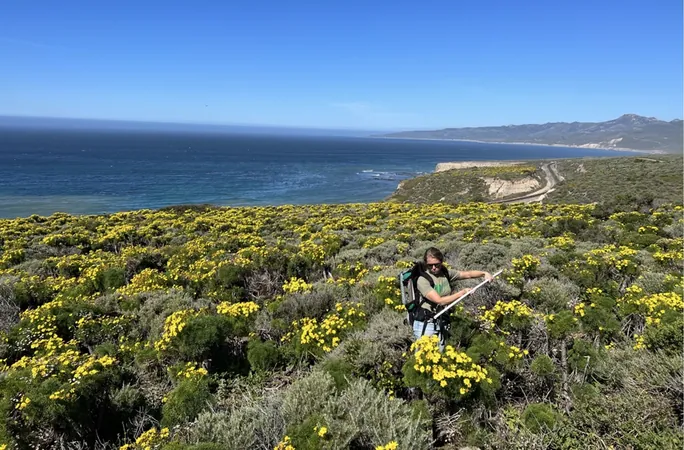
How NASA is Using Color to Track Wildflower Blooms and Tackle Climate Change
2025-03-24
Author: Benjamin
NASA is unveiling groundbreaking research that goes beyond the aesthetic beauty of flowers, aiming to unlock the secrets of our planet's changing climate. Recent studies focused on wildflowers in California illustrate how advanced aircraft- and space-based technologies can be harnessed to monitor blooming patterns by analyzing colors, thereby providing invaluable insights for farmers and conservationists alike.
Advanced Technology and Research Methods
In a pioneering survey conducted over vast nature preserves, scientists utilized imaging spectrometers developed by NASA's Jet Propulsion Laboratory (JPL) in Southern California. This sophisticated instrument mapped the landscape across hundreds of wavelengths of light, meticulously documenting the blooming and aging of flowers over several months.
Published in the journal Ecosphere, this study is the first of its kind to continuously track vegetation throughout an entire growing season, according to David Schimel, a lead research scientist at JPL. This breakthrough allows researchers to observe timely shifts in flowering caused by seasonal fluctuations in temperature, daylight, and precipitation—key components influencing vegetation phenology.
Limitations of Previous Methods
Previously, wildflower research primarily depended on ground observations and time-lapse photography. However, these methods are limited when it comes to capturing the subtle and broad changes that affect ecosystems worldwide. Yoseline Angel, a lead author and scientist at the University of Maryland-College Park and NASA’s Goddard Space Flight Center, noted that flowers are often short-lived, presenting challenges in capturing their full flowering cycles.
Utilizing Flower Pigments
To navigate around these temporal limitations, the research team is focusing on the distinct colors produced by flower pigments. These pigments, which are categorized into three main groups—carotenoids, betalains, and anthocyanins—reflect and absorb light differently, allowing for the creation of unique "fingerprints" for various plant species.
Spectrometers enable scientists to catalog these chemical fingerprints, leading to a better understanding of different biological substances and environmental factors. Over 45 years, NASA has upgraded its spectrometers for applications beyond Earth, including missions analyzing remote solar systems.
Case Study: AVIRIS-NG Instrument
One prominent instrument in use is AVIRIS-NG (Airborne Visible/InfraRed Imaging Spectrometer-Next Generation), designed for aerial surveys. In 2022, AVIRIS-NG was deployed to study vegetation in California’s Jack and Laura Dangermond Preserve and Sedgwick Reserve, observing two essential native shrub species—Coreopsis gigantea and Artemisia californica—from February to June. Remarkably, the scientists could categorize 97% of the slightest spectral differences among the flowers, leaves, and soil textures, achieving an 80% accuracy in identifying various flowering stages.
Implications for Future Research
This research holds the potential to revolutionize how scientists predict natural phenomena, such as "superblooms," where vast expanses of desert flowers blossom following heavy rain. Angel is also poised to leverage data from EMIT (Earth Surface Mineral Dust Source Investigation), a spectrometer stationed on the International Space Station, to gain further insights into these extraordinary floral displays.
The Importance of Wildflowers
Moreover, wildflowers are critical to our ecosystem, supporting vital species from pollinators to mammals. They also play a significant role in agriculture, as many crops—the backbone of our economy—are flowering plants. Angel expressed enthusiasm for engaging with citizen scientists through social media, allowing them to contribute to wildflower monitoring and observation each season.
Collaborative Efforts
In collaboration with organizations like the Nature Conservancy and the University of California, Santa Barbara, the SHIFT initiative embodies the spirit of teamwork, driving forward a comprehensive understanding of how flowers function and react in our changing world.
Join the blooming revolution! Discover how NASA's innovative technology could help secure the future of our precious ecosystems and agricultural practices. Keep your eyes peeled; the world of wildflowers is more vibrant and crucial than ever!









 Brasil (PT)
Brasil (PT)
 Canada (EN)
Canada (EN)
 Chile (ES)
Chile (ES)
 Česko (CS)
Česko (CS)
 대한민국 (KO)
대한민국 (KO)
 España (ES)
España (ES)
 France (FR)
France (FR)
 Hong Kong (EN)
Hong Kong (EN)
 Italia (IT)
Italia (IT)
 日本 (JA)
日本 (JA)
 Magyarország (HU)
Magyarország (HU)
 Norge (NO)
Norge (NO)
 Polska (PL)
Polska (PL)
 Schweiz (DE)
Schweiz (DE)
 Singapore (EN)
Singapore (EN)
 Sverige (SV)
Sverige (SV)
 Suomi (FI)
Suomi (FI)
 Türkiye (TR)
Türkiye (TR)
 الإمارات العربية المتحدة (AR)
الإمارات العربية المتحدة (AR)